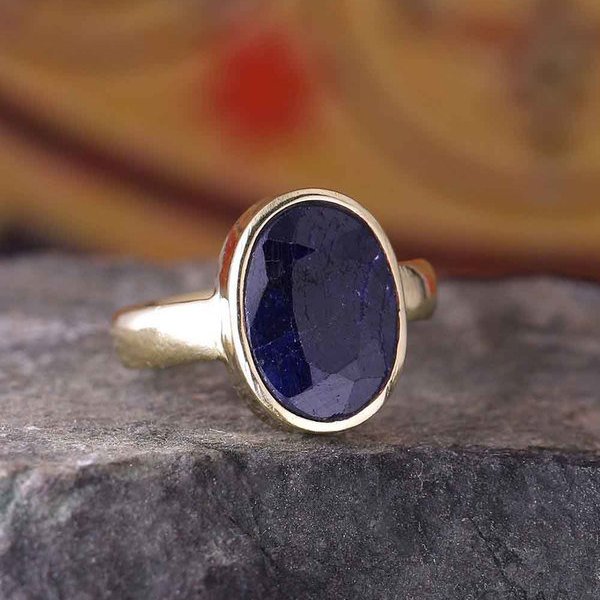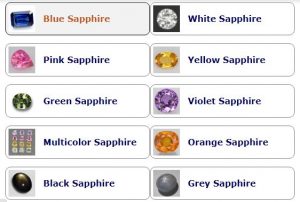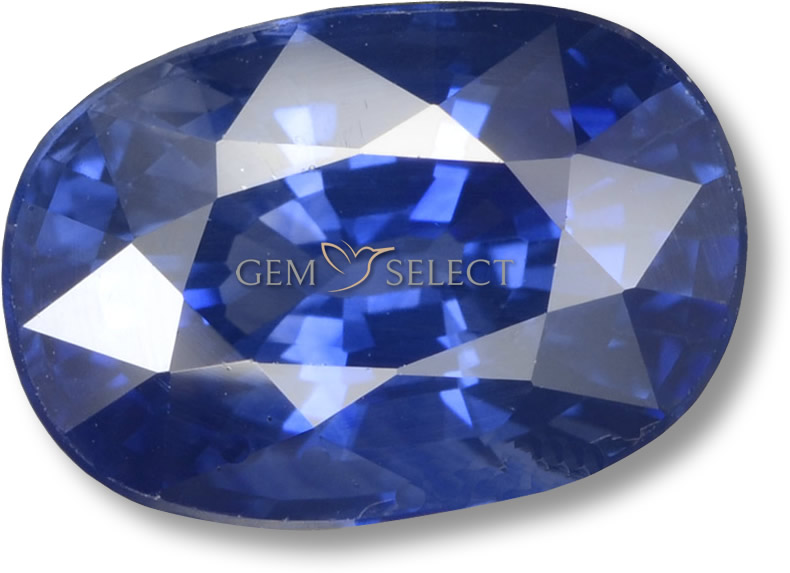
About Sapphire – History and Introduction
Sapphire is a gem quality variety of the mineral corundum. It is the second hardest substance on earth after diamond, rating 9 on the Mohs scale of mineral hardness. Corundum itself is not a very rare mineral, but gem-quality corundum is extremely rare. Most corundum is opaque to translucent and heavily included, suitable only for industrial use, including the production of abrasives used for sandpaper and machining of metal, plastics and wood. The name corundum comes from the Sanskrit word kuruvindam, meaning “ruby sapphire”, while the name sapphire comes from the Persian word safir, derived from the Greek word for blue. In times of antiquity and the Middle Ages, the term sapphire actually referred to lapis lazuli, but in the early 19th century, the description and definition of sapphire was changed to the corundum variety we know today.
While blue is the most traditional and classic color for sapphire, sapphire is actually found in a variety of different colors. Most natural sapphire is quite pale and light in color. Only a small percentage of natural sapphire exhibits vivid and intense colors without some type of treatment or enhancement, the most common being heat-treatment. For many years, only blue sapphire was recognized as ‘true’ sapphire. Today, all colors of gem-quality corundum are known as sapphire, with exception to red corundum, which is classified as ruby. There is no definitive demarcation between red ruby and sapphire; in most cases, near-red sapphire would be classed as inferior colored ruby. Thus, it is common practice to trade near-red sapphire as a quality fancy color sapphire, rather than as a lower grade ruby.
Colored sapphire (other than blue) is often referred to as fancy sapphire, and fancy sapphire is typically traded using color-specific names, such as yellow sapphire, green sapphire, or purple sapphire. In the past, there were several misleading names used for fancy sapphire varieties, most of which are no longer used, such as ‘Oriental peridot‘, a term which was used to refer to green sapphire.

|
Identifying Sapphire
Sapphire is any form of gem-quality corundum, other than red (ruby). It is the second hardest mineral on earth next to diamonds. Sapphire lacks cleavage but can exhibit a conchoidal, uneven fracture. Chemically, sapphire is an aluminum oxide with a specific gravity or density ranging from 3.95 to 4.03 depending on the specific sapphire variety. Its refractive index ranges from 1.762 to 1.788 and its crystals can exhibit a weak level of double refraction or birefringence (0.008). Sapphire belongs to the trigonal crystal system, structured with three planes of symmetry and four axes. The exact crystal form depends on the specific variety and origin. Owing to sapphire’s superior hardness and durability, it’s nearly unmistakable, despite the fact that there are several other gem types that occur with similar colors and luster. Some of the most easily confused gem types include spinel, zircon, beryl, tourmaline, and chrysoberyl.
Sapphire: Origin and Sources
Sapphire is found in only a few locations in the world. The three most famous regions for blue sapphire are Kashmir, Burma, and Sri Lanka. Sapphire has also been mined in Cambodia, Thailand, Vietnam, and India. As of 2007, Madagascar has been leading the world in sapphire production, though Sri Lanka continues to be the only steady producer of fine quality blue sapphire. Sri Lanka and Madagascar produce sapphires in a wide range of colors and whilst Sri Lanka has been a known sapphire source for centuries, sapphire deposits in Madagascar were only recently discovered in 1998. The enormous deposits found in the village of Ilakaka came as a big surprise and led to a gemstone fever reminiscent of the 19th century Californian gold rush. Today, Madagascar and Tanzania are considered to be two of the most important sapphire sources. Australia is also known for significant sapphire deposits, though most Australian sapphire is known to form rather dark in color. In the USA, there are small sapphire deposits found throughout Montana and North Carolina.
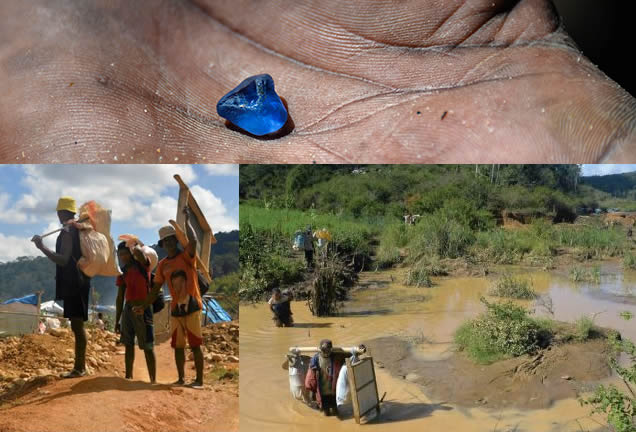
The finest quality blue sapphire, based on past auction prices, comes from Kashmir and Mogok, Burma. The finest Kashmir and Burmese sapphires display superb color and clarity without any thermal (heat) treatment. In recent times, limited resources in Burma have led miners to focus on more plentiful Burmese ruby. Some Sri Lankan (Ceylonese) sapphires are also unheated, but nowadays, the majority of sapphires have been heated, diffused or fracture-filled to improve color and clarity, regardless of their origin. The Kashmir mines, high up in the Himalayas, have produced spectacular world-renowned gems, but since the 1920s, virtually no new material has been found. The rare, fine blue sapphires of Pailin, Cambodia was also very highly regarded by gem traders throughout the world. Pailin sapphires ranged in color from light to deep blue, but they possessed a distinctive purity and intensity of color that was unlike any other sapphire sources. Many gem traders graded them as close in quality to Kashmir and Burmese sapphires; and certainly superior to Sri Lankan (Ceylonese), Thai, American, Vietnamese, Indian, African, and Australian sapphires.
Almost all the sapphires from around the world are cut and processed in Chanthaburi, Thailand. Along with Kanchanaburi and Trat, Chanthaburi was once one of the main sources for Thai sapphire. Sapphire mining in Chanthaburi is mostly finished now, though there are a few small private mining locations scattered throughout the province. There is also a large market for Thai star sapphires that exhibit distinctive golden six-rayed stars. The golden black star sapphire is found nowhere else in the world. Nowadays, Chanthaburi, Thailand has become the main processing and trading center for almost all of the world’s sapphires, rubies, and other colored gemstones.
Buying Sapphire and Determining Sapphire Value
Sapphire Colors
Blue is indeed the best-known and the most valuable of sapphire colors. The prized Kashmir and Burmese sapphires have a deep blue that is described as both intense and velvety. These sapphires are not often seen on the market today. Sri Lankan and Madagascar sapphires are the most common today, with a wide range of colors from light blue to dark blue. With blue sapphire, the intensity of blue is the most important factor. For example, a huge sapphire with a washed-out, weak blue color is much less valuable than a much smaller stone of excellent color. An intense, rich pure cornflower blue that is not too dark or too ‘inky’ is the most desirable color. Overall, sapphires that are too dark or too light in color are less valuable, but light-blue sapphires often have greater brilliance that is rarely found in darker blue stones. Colorless sapphires are actually quite rare since most stones will exhibit some faint hints of color. In the gem trade, when referring to sapphire, blue sapphire is the official designation; all other colors, including pink, green, orange, purple and white sapphire, are referred to as ‘fancy sapphire‘.
Sapphire colors are best viewed under natural daylight. In artificial or incandescent light, sapphire colors can appear darker and inky black-blue. Many may even appear redder and less attractive than they really are. Sapphire colors are a result of trace impurities. The coloring agents found in blue sapphire are typically iron and titanium. Violet stones are colored by vanadium. Pink sapphire and purple sapphire are often colored by iron and titanium impurities. Most yellow sapphire is naturally on the lighter side. It is through heat treatment that a more intense yellow golden color is produced. Beryllium-treated sapphire may result in brilliant bright yellow. Small traces of iron can cause yellowish and greenish hues in stones. Chromium is known to produce fine pinks (and red in ruby), whilst iron and vanadium together can produce lovely orange stones. Padparadscha sapphire is a very rare sapphire with a pinkish-orange hue. A true padparadscha will always have a hint of pink. Many ‘green’ sapphires consist of fine alternating bands of blue and yellow sapphire, which are visible under a microscope.
Sapphire Clarity and Luster
Sapphire can occur transparently to opaque. Transparent materials are the most valuable. Some translucent materials are cut into beads or cabochons. Opaque materials have very little gemstone value, although they may sometimes be used for ornamental carvings. Sapphires are generally cleaner than ruby, so it is best to look for stones that are eye-clean. Eye-clean stones in larger sizes are quite rare, especially in ideal colors. In some cases, extremely fine silk throughout the stone can enhance the value of some sapphires. The famous sapphires from Kashmir have a velvety blue color which is caused by this fine silk. This same silk causes the asterism seen in star sapphires. However, too much silk weakens the color, rendering it an undesirable grayish color. The rutile needles that are responsible for the silky shine reflect the light in sixty-degree angles. If the rutile needles are perfectly aligned in the same direction, the inclusions can result in six-rayed asterism when cut en cabochon and viewed under strong light. Sapphire exhibits an attractive vitreous luster.
Sapphire Cut and Shape
Various shapes and cutting styles are common with sapphires. Ovals, cushions, and rounds are commonly seen, as are other shapes, such as fancy hearts, pears, and emerald cuts. Round stones can command very high premiums, especially in diamond-cut calibrated stones weighing 1 carat or more. Cabochons are common for translucent stones or for stones with visible inclusions. Briolettes, beads and tumbled sapphire can also be found but is usually lower grade material.

Sapphire Treatment
The most common treatment for sapphire is heat treatment, though unheated sapphire specimens can be found. Stones are heated (generally before they are cut) to between 1700 to 1800 degrees Celsius (3100-3300 degrees F) for several hours. Most sapphires today are heated, and unheated stones in rich blue can command enormous prices in today’s market. Some blue sapphires may also be diffusion treated, though this treatment is more common for star sapphires. Beryllium treatment is now being used to produce stunning orange and red colors that were once rarely seen. All sapphire treatments should be fully disclosed by any reputable dealer.
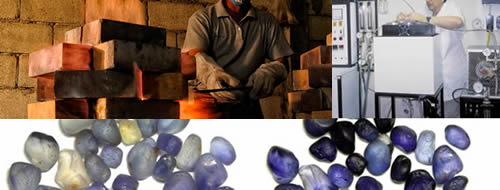
Sapphire Gemological Properties:
| Chemical Formula: | Al2O3, Aluminum oxide |
| Crystal Structure: | (Trigonal), double pointed, barrel-shaped, hexagonal pyramids, tabloid shaped |
| Color: | Blue, colorless, pink, orange, yellow, green, purple, black |
| Hardness: | 9.00 on the Mohs scale |
| Refractive Index: | 1.762 – 1.788 |
| Density: | 3.95 to 4.03 |
| Cleavage: | None |
| Transparency: | Transparent to opaque |
| Double Refraction or Birefringence: | 0.008 |
| Luster: | Vitreous |
| Fluorescence: | Blue: none; colorless: orange-yellow, violet |
Please refer to our Gemstone Glossary for details of gemology-related terms.
Sapphire: Related or Similar Gemstones
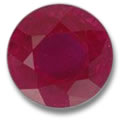
There are also a variety of trade names used for specific forms of sapphire, such as star sapphire and color-change sapphire. Ruby-zoisite is a mixture of corundum (ruby) and zoisite (the same material as tanzanite) formed within the same stone. Since sapphire comes in such a wide variety of colors, it can be easily confused with many other gemstones such as zircon, beryl, chrysoberyl, spinel, tourmaline, and quartz. However, sapphire has superior hardness and durability which can easily distinguish it from other similar colored gemstones.
Sapphire Mythology, Metaphysical and Crystal Healing
Sapphire is the birthstone for those who are born in September. As for the zodiac, it is regarded as the stone for Taurus. If a Taurus wears a sapphire, it is thought to protect from and cure mental disorders.
Throughout history, sapphire has symbolized truth, sincerity, and loyalty. It is also thought to bring peace, joy, and wisdom to its wearer. In the past, the sapphire was also believed to be a talisman that would protect against evil spirits and other unsavory creatures of the night. The ancients regarded star sapphires as powerful talismans that could protect travelers and seekers. These talismans were considered to be so powerful, that they would continue protecting the wearer even after they had been passed on to another person.
Abbess Hildegard von Bingen (1098-1179) chronicled the healing powers of gemstones in her book, Physica. According to her view, gemstones are formed through the powerful combination of water and fire; therefore they hold powers corresponding to these natural phenomena. She also believed that each stone had a certain, divine blessing from God. She said the following about sapphire: “Who is dull and would like to be clever, should, in a sober state, frequently lick with the tongue on a sapphire, because the gemstone’s warmth and power, combined with the saliva’s moisture, will expel the harmful juices that affect the intellect. Thus, the man will attain good intellect.”
| Disclaimer: Metaphysical and Alternative Crystal Healing Powers and Properties are not to be taken as confirmed advice. Traditional, Ceremonial and Mythological Gemstone Lore is collected from various resources and does not represent the sole opinion of SETT Co., Ltd. This information is not to replace the advice of your doctor. Should you have any medical conditions, please see a licensed medical practitioner. GemSelect does not guarantee any claims or statements of healing or astrological birthstone powers and cannot be held liable under any circumstances. |
Sapphire Jewelry Design Ideas
Sapphire is one of the ‘precious four‘ gems, which also includes red ruby, green emerald, and fine diamond; and so it is often seen in fine jewelry. Sapphire is one of the few colored gemstone varieties that can often be found in local retail jewelry stores. Next to diamond, sapphire is one of the most popular gemstones today, found in just about every design from exquisite brooches, pins, pendants, rings, and necklaces to simple and classic traditional designs such as sapphire rings, sapphire studs or sapphire earrings. Sapphire is also an excellent gemstone carving material.
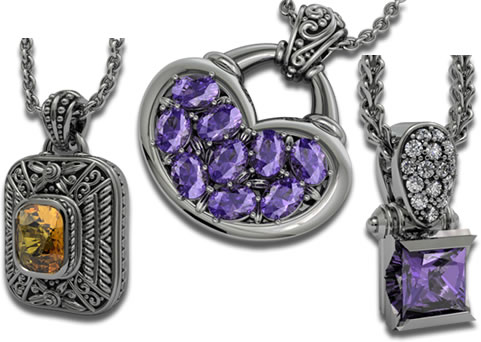
You can often find ornamental carvings of animals and flowers made from some lower-grade sapphire. Briolettes make for excellent sapphire earrings or pendants. Sapphire prices can range from extremely expensive to surprisingly affordable, so they can be used for anything from costume jewelry to high-end designs. Unheated sapphire is rare and expensive, while treated sapphire stones can be had at very affordable prices.
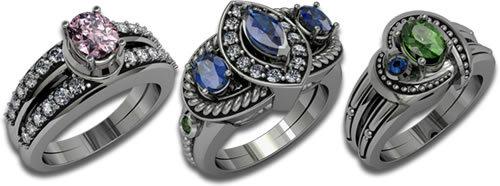
Note: Buy colored gemstones by size and not by carat weight. Colored stones vary in size-to-weight ratio. Some stones are larger and others are smaller than diamonds by weight in comparison.
Famous Sapphire Gemstones
Large sapphires are rare and often attract fame and myth. The largest star sapphire is the Star of India, which weighs an amazing 536 carats. Discovered about three hundred years ago in Sri Lanka, the Star of India was donated to the American Museum of Natural History by the financier J.P. Morgan. Later the infamous burglar, Jack Murphy, (AKA “Murphy the Surf”), stole the stone. Its recovery two months later only added to its fame.
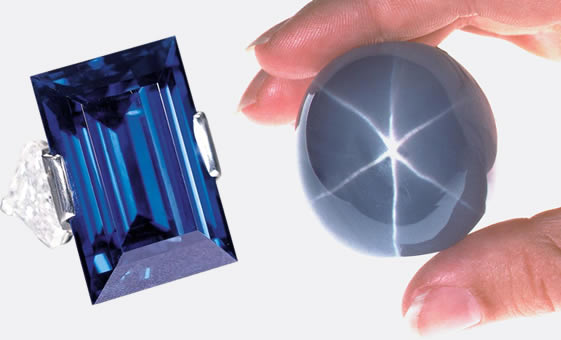
The Rockefeller Sapphire was purchased in 1934 by John D. Rockefeller from an Indian maharajah (believed to be the Nizam of Hyderabad) for an undisclosed price. It is a 62.02-carat faceted blue sapphire, in a rectangular step cut, mounted in a diamond ring. It was first sold by Sotheby’s in 1988 for $2.82 million and then sold by Christie’s in 2001 for $3,031,000 or approximately $48,871 per carat.
The 423 carats Logan Sapphire is displayed in the Smithsonian Museum of Natural History. It is the largest faceted sapphire on public display and perhaps the largest known blue sapphire. This egg-sized, cushion-cut stone from Sri Lanka is set in a brooch surrounded by 16 carats of diamonds. It was donated by Mrs. John A. Logan to the Smithsonian Institute in 1960.
Other famous sapphires include the Midnight Star, a 116-carat black star sapphire. The intensely blue 330 carat Star of Asia can be found in the American Museum of Natural History. Also, the English Crown Jewels contain two famous sapphires; the St. Edward’s and the Stuart Sapphire (104 carats).
Sapphire Gemstone Jewelry Care and Cleaning
 Sapphire can be cleaned using a soft cloth or brush and plain warm soapy water. After wiping, be sure to rinse your sapphire well to remove soapy residue. Sapphire can change color under extreme heat, so avoid extreme temperature fluctuations. Also avoid the use of any harsh household chemicals and cleaners, including bleach or hydrofluoric acid, as chemicals can cause corrosion.
Sapphire can be cleaned using a soft cloth or brush and plain warm soapy water. After wiping, be sure to rinse your sapphire well to remove soapy residue. Sapphire can change color under extreme heat, so avoid extreme temperature fluctuations. Also avoid the use of any harsh household chemicals and cleaners, including bleach or hydrofluoric acid, as chemicals can cause corrosion.
Sapphire is quite durable, but it is still recommended to always remove any sapphire jewelry before engaging in vigorous physical activity, especially when exercising or playing sports. When removing jewelry, do not pull from the stone as this can weaken prongs, eventually leading to a lost stone. When storing sapphire gemstones, wrap them in a soft cloth or place them inside a fabric-lined jewelry box.
Source: https://www.gemselect.com/gem-info/sapphire/sapphire-info.php

